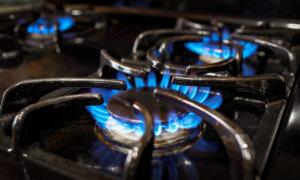The administration’s order would mean higher costs for 14 percent of low-income households and 20 percent of small business consumers, an industry group said.
The U.S. Senate passed a resolution on May 21 repealing a Biden administration policy forcing many Americans to ditch their gas furnaces and rely on electric ones.
“This standard is readily achievable by modern condensing furnaces, which use secondary heat exchangers to capture excess heat from the furnace’s exhaust gases,” the agency said.
He pointed out that the DOE rule “will effectively ban all non-condensing furnace models, coercing a majority of American households to adopt electric heat pumps or pay thousands of dollars to renovate their homes to meet the requirements of new residential gas furnaces.”
While announcing the rule, the DOE justified it by claiming that the new standards for gas furnaces reduce household utility costs by $1.5 billion yearly and lower “greenhouse gas emissions.”
Over a period of 30 years, the standards are predicted to save consumers $24.8 billion.
“As of 2022, residential gas furnaces account for approximately 19 percent of annual residential energy use in the United States. DOE expects that updating efficiency standards for these appliances will, over 30 years, cut carbon emissions by 332 million metric tons.”
This is approximately equal to the combined annual emissions of 42 million homes or roughly 34 percent of American homes, the agency stated.
The standards were proposed and finalized by the Biden DOE as part of a “broader, radical campaign” against fossil fuels, natural gas, and other sources of energy crucial to the American economy and households, he said.
Industry Opposition
In comments submitted to the DOE when the gas furnace rule was proposed, the National Caucus of Environmental Legislators backed the measure. They argued that increasing gas efficiency will ease customers’ heating bills.
“Low-to-moderate income households have a disproportionately higher energy burden on average than other households in America,” the caucus wrote.
“The payback period for gas furnaces under this proposed standard is only 2.1 years for low-income consumers, at which point these households would be reaping the full financial benefit from the updated standard.”
At present, around 40 percent of non-weatherized natural gas furnaces sold to customers are non-condensing, they wrote, adding that millions of homes and businesses were designed for such furnaces.
“DOE’s data shows that the proposal will result in higher overall costs for 15 percent of senior-only households, 14 percent of low-income households, and 20 percent of small business consumers. … DOE should not issue a rule with such unacceptable impacts on low-income households, seniors, and energy insecure consumers.”
Stuart Saulters, APGA’s vice president of government relations, called the DOE policy “especially concerning” as it could force “vulnerable, underserved communities,” potentially to shift to less affordable electric furnaces, which also tend to be less efficient than the direct use of natural gas.
“DOE determined that these standards will result in significant conservation of energy, are technologically feasible, and economically justified, providing an estimated $1.5 billion each year in savings on household utility bills—with an average household that upgrades from a legacy model saving an estimated $500 over the new furnace’s lifetime,” the administration said.
“Passage of S.J. Res. 58 would eliminate these commonsense energy efficiency standards that promote choices for consumers to help them save money, prevent waste of electricity and gas, and strengthen energy security.”
Original News Source Link – Epoch Times
Running For Office? Conservative Campaign Consulting – Election Day Strategies!


